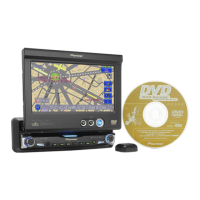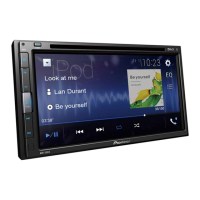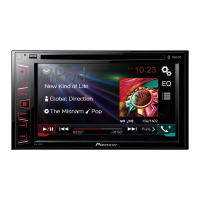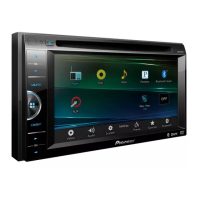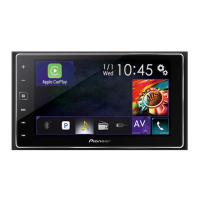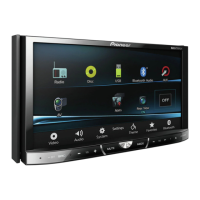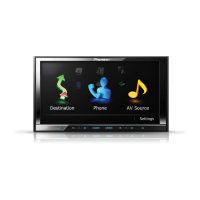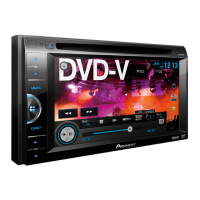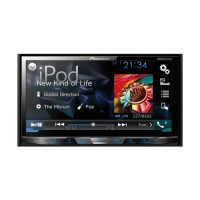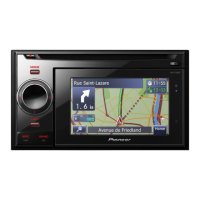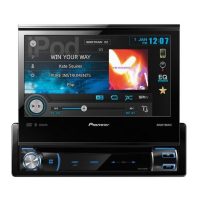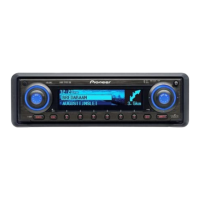
Do you have a question about the Pioneer ANH-P9R-BK and is the answer not in the manual?
| Brand | Pioneer |
|---|---|
| Model | ANH-P9R-BK |
| Category | Car Receiver |
| Language | English |
Brief overview of the manual's purpose and scope.
Legal terms and conditions for using the software and product.
Crucial safety guidelines for operating the navigation system.
General information about the product's features and compliance.
Guidance on how to best use the operation manual.
Important considerations and warnings for using the product.
Steps to take if the product fails to operate correctly.
Instructions on detaching and securing the front panel to prevent theft.
Procedure to reset the unit's microprocessor in case of errors.
Information on the product's reverse and feature demonstration modes.
Identification of buttons and controls on the main unit.
Information about the separately sold steering remote control.
How to select and switch between different audio sources.
Displaying navigation and audio information at the same time.
Understanding how multi-function buttons change based on context.
Illustrates operation of multi-function buttons using random play.
Explains the distinct functions of BAND/ESC and BACK buttons.
Visual examples of the display during CD player operation.
Explanation of indicators that show usable buttons on the display.
Definition and basic principles of vehicle navigation systems.
Details about the street map data included on the navigation CD.
Mandatory safety precautions to follow while using navigation.
Important general information regarding navigation operation.
Prerequisites and initial setup before starting navigation.
Basic steps to initiate and operate the navigation system.
Overview of the primary menu options for navigation.
Steps to begin entering a destination address.
How to choose the destination country for map data.
Detailed process for inputting destination addresses.
Guide to inputting road names for destination entry.
Steps for entering a destination by specifying a town center.
How to enter a destination using a postal code.
Options available after destination entry for route calculation.
Procedure to add a house number to a destination road.
How to specify an intersection as the destination.
Options to configure route calculation preferences.
Guide to saving frequently used destinations for easy recall.
How to remove saved destinations from memory.
Action to take when the destination memory is full.
Process and display messages during route calculation.
How the system recalculates routes when deviating.
Functionality for adding intermediate stops to a route.
Steps to input a stopover location.
Initiating route calculation with a stopover included.
Procedure to remove an entered stopover.
Indication when a stopover point has been reached.
How to bypass traffic jams or road blocks.
Specifying the distance to avoid traffic congestion.
Option to cancel a traffic jam bypass.
Steps to terminate active route guidance.
Important tips and information about route guidance displays.
Using real-time traffic information for route adjustments.
Explanation of how dynamic routing uses traffic data.
How to activate and utilize dynamic route guidance features.
How to view current traffic announcements and details.
Accessing traffic information when route guidance is inactive.
Displayed information like ETA and distance during active guidance.
How to check total travel time and distance.
Viewing the parameters used for the current route calculation.
How to display the current time on the system.
Obtaining detailed information about the vehicle's current location.
Viewing the list of roads along the planned route.
Managing stored destinations for quick access.
Selecting points of interest like gas stations or hospitals.
Finding special destinations within a specific town.
Searching for special destinations across different countries.
Accessing and configuring various system parameters.
Adjusting the internal clock to the correct local time.
Storing the current vehicle location in memory.
Retrieving and displaying saved positional data.
Changing the system's display and voice language.
Enabling or disabling ETA announcements.
Setting and displaying the estimated average speed.
Choosing between metric and imperial units for distance.
Overview of the tuner's display elements and indicators.
How to tune into stations, adjust volume, and change bands.
Methods for saving and retrieving favorite radio stations.
Accessing advanced tuner settings and RDS functions.
Automatic storage of the six strongest available stations.
Using local seek tuning for better reception quality.
Overview of RDS indicators like AF, TXT, and PTY.
Explanation of the Radio Data System and its features.
How to view station frequency or PTY information.
Automatically searching for stronger signals on the same network.
Searching for stations broadcasting the same program using PI Seek.
Enabling PI Seek during preset station recall for long-distance travel.
Using the regional function with AF to tune regional programs.
Activating the TA function to receive traffic alerts automatically.
How to enable or disable the traffic announcement standby.
Steps to stop an active traffic announcement and return to the original source.
Setting the volume level for traffic announcements.
Reminder to select another TP station due to weak signal.
Searching for stations based on program type (PTY).
How to perform a program type search.
Automatically switching to news broadcasts.
Special PTY code for emergency announcements.
A comprehensive list of program types (PTY) for station searching.
Displaying text information transmitted by RDS stations.
How to view station information, song titles, and artist names.
Saving up to six radio text broadcasts.
Retrieving previously stored radio text.
Overview of display elements for the CD player.
How to insert, play, and eject CDs.
Displaying and navigating text information (artist, title) on CD TEXT discs.
Accessing advanced functions like repeat, random, and scan.
Options for playing tracks repeatedly (one-track, disc, magazine).
Playing tracks in a shuffled sequence.
Playing the first 10 seconds of each track.
Choosing tracks by title from a CD TEXT disc.
Temporarily stopping and resuming CD playback.
Inputting custom titles for discs.
Overview of the multi-CD player's display elements.
Selecting discs, tracks, and adjusting volume.
Note on supported features for 50-disc models.
How to choose a specific disc from the magazine.
Displaying and navigating text information on compatible discs.
Accessing advanced multi-CD player functions.
Options for repeating playback of tracks, discs, or the magazine.
Shuffling playback within selected repeat ranges.
Previewing the start of tracks or discs.
Choosing tracks by title from a CD TEXT disc.
Choosing discs by their entered titles.
Temporarily stopping and resuming playback.
Inputting custom titles for up to 100 discs.
Adjusting sound quality with COMP and DBE functions.
Creating and managing a program of favorite tracks.
Steps to add tracks to the ITS memory.
Playing only the tracks stored in ITS memory.
Removing a specific track from the ITS memory.
Removing all tracks of a CD from ITS memory.
Overview of the DAB tuner's display elements and indicators.
Lights indicating activated DAB tuner functions.
Symbols indicating service status (EXTRA, TXT, DAB).
Selecting DAB services, adjusting volume, and changing bands.
Methods for saving and retrieving DAB services.
Switching between DAB bands (DAB 1, 2, 3).
Changing the information shown on the DAB display.
Function for displaying dynamic text information.
Enabling or disabling traffic flash alerts.
Stopping traffic flash interruptions and returning to the original source.
Saving dynamic label data to memory buttons.
Retrieving stored dynamic labels.
Accessing DAB tuner specific functions like PTY search.
Configuring how announcements interrupt DAB reception.
Choosing services from stored presets.
Selecting services from the list of currently available ones.
Finding stations based on program type within the current ensemble.
Overview of TV tuner display elements and indicators.
How to select TV tuner, adjust volume, and tune channels.
Methods for saving and retrieving TV channels.
Switching between TV bands (TV 1, TV 2).
Accessing TV tuner specific functions.
Choosing channels from the list of stored presets.
Applying preset or custom equalizer sound profiles.
Accessing various audio adjustment settings.
Adjusting front/rear and left/right speaker balance.
Fine-tuning equalizer levels, frequencies, and Q factor.
Adjusting the cut-off frequency and level for bass.
Compensating for sound deficiencies at low volumes.
Adjusting the cut-off frequency and level for treble.
Enabling and configuring the subwoofer output.
Fine-tuning subwoofer cut-off frequency and output level.
Balancing volume levels between different audio sources.
Adjusting sound staging for optimal listening positions.
Overview of the menu for initial product setup.
How to access and navigate the initial settings menu.
Enabling a mode where screen indications reverse periodically.
Activating the product's automatic demonstration mode.
Enabling or disabling the auxiliary input for external equipment.
Turning the visual navigation guide animation on or off.
Configuring audio muting or attenuation during voice guidance.
Choosing audio output speakers for navigation guidance.
Adjusting the frequency step for FM tuning.
Enabling or disabling the tone that reminds to detach the front panel.
Configuring rear output for full-range speakers or subwoofer.
Prioritizing DAB traffic announcements over RDS TA.
Enabling automatic PI Seek during preset station operation.
Quickly lowering the audio volume significantly.
Turning the time display feature on or off.
What is shown when the time display is on but sources are off.
Modifying display brightness for different lighting conditions.
Automatically dimming the display when headlights are on.
Choosing from available background patterns for the display.
Connecting and using external audio equipment via AUX.
Setting AUX as the active audio input.
Customizing the display title for the AUX source.
Guidelines for using and maintaining CDs and the player.
Information and precautions regarding recordable and rewritable discs.
Troubleshooting common CD player error codes.
Details on how traffic information is received and limitations.
Legal notices regarding data sources and ownership.
Technical details and performance data of the product.
